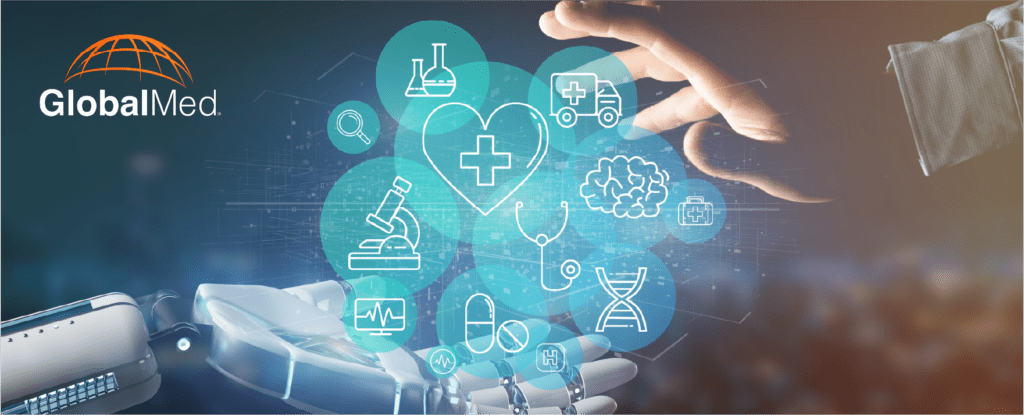
In any dialogue about telemedicine, you’ll hear a lot of talk about access to care. But there’s another conversation that needs more attention: what kind of care does telemedicine offer? See, while GlobalMed can already connect patients to EKGs, ultrasounds and advanced teledentistry, we’re also opening the door to even more advanced breakthroughs in medicine.
Technology is becoming interwoven with healthcare. Researchers use virtual reality games to detect genetic predisposition to Alzheimer’s disease. Google wants to implant sensory devices into senior living facilities to detect falls and use patients’ smartphones to measure hemoglobin levels and diagnose asthma. Nanomedicine can treat cancer and heart disease by using nanobots to repair damaged cells, correct genetic deficiencies, replace DNA molecules and unblock arteries.
While there’s considerable excitement over such advances, healthcare’s digital revolution won’t just change the care we receive – it will transform how we receive it. We’re moving into a future where virtual care is not just convenient but required.
The Exponential Evolution of Medicine
Telemedicine provides the building blocks in a world where technology and healthcare are inseparable. Specialized treatments won’t always be available in the county hospital or from the local general practitioner. Those providers will need to collaborate with remote specialists. Many treatments themselves – such as nanobots equipped with wireless transmitters or physicist Michio Kaku’s diagnostic smart bathrooms – will depend on virtual technologies.
In fact, just as we recoil today from the idea of treating epilepsy with leeches or giving heroin to children with sore throats, we may soon look back on some of our current practices as clumsy and even dangerous. The oncoming wave of medical innovations do more than transcend current treatments – they transcend the need for in-person visits and treatment delays. The idea of waiting four hours for an emergency room visit or needing six months to develop a pandemic vaccine may soon seem primitive.
Consider the following scenario:
A microscopic robot is implanted inside your daughter at birth. Whenever an illness begins, before she feels a symptom, it sends alerts to you and her doctor. Immediately the doctor prescribes genome-based drug therapies concocted for her biology and sends the medication to you by drone. Your health is also monitored by sensory equipment connected to remote specialists. Before you can feel a cancer symptom or travel to a distant hospital for a CT scan or MRI, nanobots collect tissue samples, replace damaged cells with healthy cells and absorb any toxins in your blood. Even your elderly father with Parkinson’s no longer needs to be taken to his neurologist’s office; internal nanobots discharge dopamine in a specific location in his brain.
Sure, some of that sounds unbelievable. But that doesn’t mean it isn’t realistic. Inventor and Google Director of Engineering Ray Kurzweil says accurate futuristic ideas can seem outlandish because our human brains are designed to think in linear terms – but technology evolves at an exponential rate.
Tomorrow Starts Today
If you’re unconvinced of where healthcare is headed, consider this. A 1962 episode of “The Jetsons” had George Jetson swallowing a Peek-A-Boo Prober Capsule which traveled around the inside of his body showing his organs to the doctor. “You just swallow it and it transmits pictures to a TV screen,” the doctor explained.
Sounds crazy, right? A silly and exaggerated cartoon idea about the future. Yet capsule endoscopy was approved by the U.S. Food and Drug Administration (FDA) in 2001. After the patient swallows a pill-sized video camera, pictures of the gastrointestinal tract are sent to a recording device for the doctor to examine.
In the same way, some of our wild ideas about futuristic medicine may one day be just another common medical procedure. After all, leech therapy has made a surprising comeback, with maggots and leeches classified by FDA as the first live medical device. The future will likely surprise us in multiple ways.
But we do know one thing now: this is the time for every provider to establish their telemedicine foundation. Tomorrow’s healthcare advances will offer the richest benefits when we all collectively move together – payers, major health networks, small-town doctors, specialty clinics and patients – to adopt virtual care. Telemedicine already offers cost savings, global access to treatment and better health outcomes. By developing delivery models that work with oncoming innovations, we can accelerate a new era of advanced medicine across the globe.
Let GlobalMed guide you to the telemedicine solution that is right for you. Start by contacting us or scheduling a demo. A seasoned expert is on hand to help.
